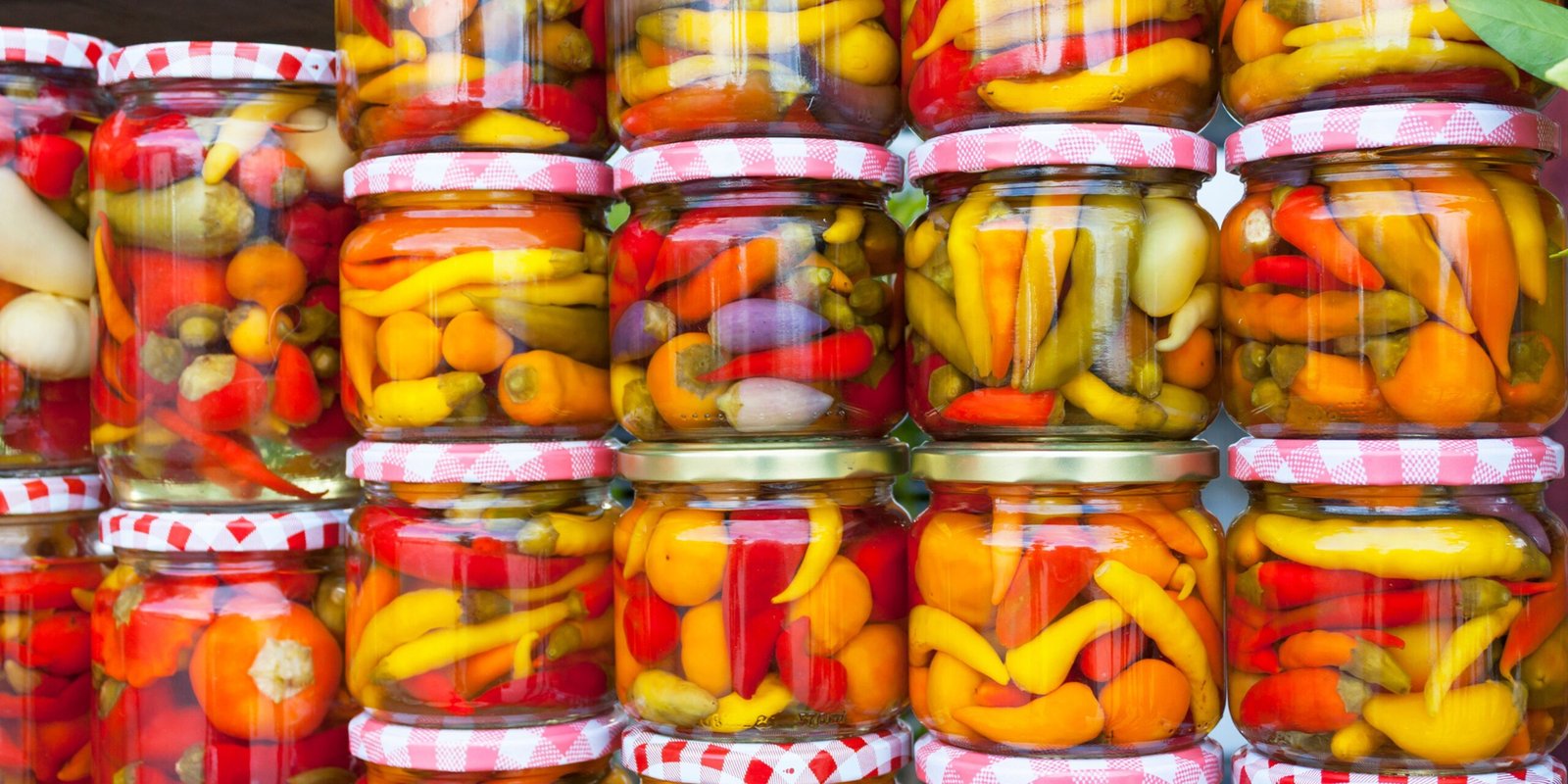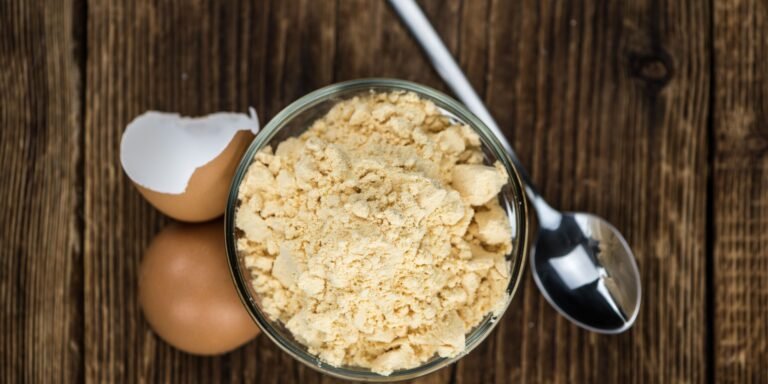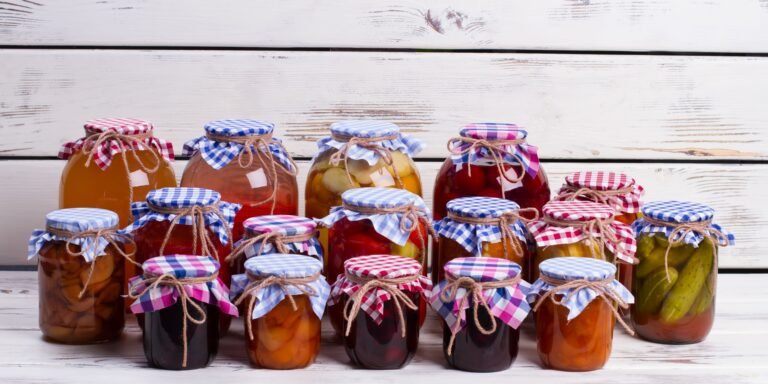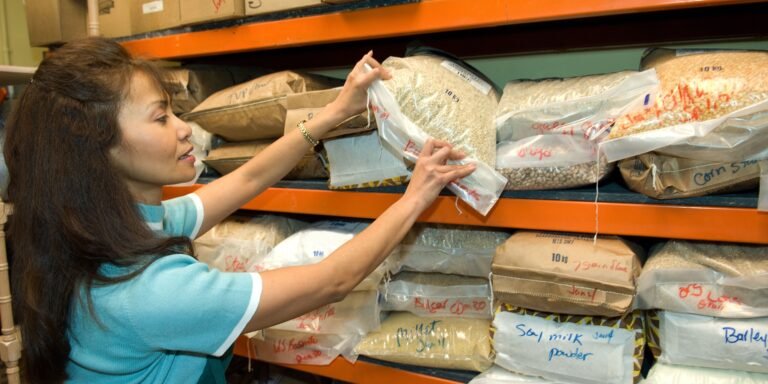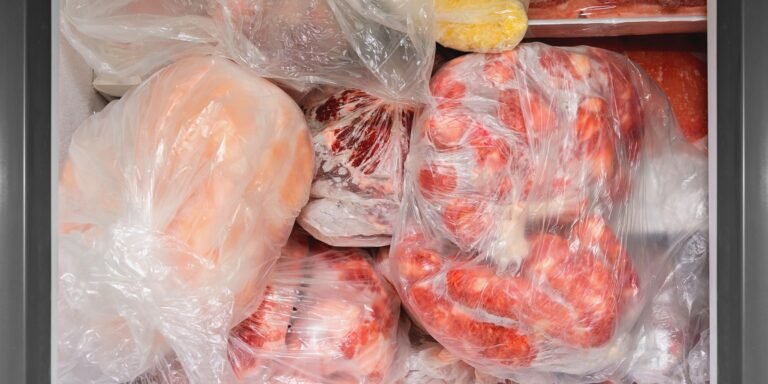The Ultimate List Of Non-Perishable Foods To Store In Emergency
This post may contain affiliate links, full disclosure here.
We’ve compiled a list of specific food items to make it easier for you to find quality bulk items that are worth adding to your pantry after spending countless hours researching food storage and putting together a food storage calculator (to help individuals and families determine how much food they need in their storage), after spending countless hours researching food storage and putting together a food storage calculator (to help individuals and families determine how much food they need in their storage).
We organized our recommended food storage goods based on our food storage calculator for your convenience.
See also: Top 20 Barter Items to Stockpile
Best Long Term Food Storage List
The following foods are the best for long-term food storage:
- Grains (Wheat, Rice, Flour, Oats, Pasta, etc.)
- Canned and Dried Meats
- Fats and Oils (Vegetable Oil, Shortening, etc.)
- Beans
- Milk and Dairy
- Sugars
- Cooking Essentials (Salt, Yeast, Baking Powder/soda, etc.)
- Fruits and Vegetables (Freeze Dried and Canned)
- Full Freeze Dried Meals (Breakfast, Dinner, etc.)
- Bulk Freeze Dried Meals (Just add water)
See also: How To Store Quinoa Long-Term
What are the best foods for long-term storage?
Start looking for a company that makes food that is meant to be preserved for the long term as a simple and wonderful way to get the greatest meals for long-term storage. These businesses freeze-dry and package foods, even entire meals, with the goal of preserving nutritional value while storing them for years. Augason Farms is a firm that we’ve recently been tasting and appreciating their cuisine.
Rice
Rice is a must-have food for stockpiles since it is inexpensive, easy to obtain, and store for a long shelf life.
Rice can keep for up to 30 years if stored properly in food-grade containers and food storage bags.
Rice (brown)
Brown rice is a gluten-free, very nutritious grain that is strong in vitamins, minerals, and therapeutic chemicals. Whole grains, such as brown rice, can help prevent or alleviate a variety of health problems, including as diabetes and heart disease. Shelf life of up to 7 years!
Rice that is white
White rice is milled rice that has been stripped of the husk, bran, and germ. This changes the rice’s flavor, texture, and appearance, as well as preventing spoiling and extending its shelf life. Shelf life of up to 30 years!
Jasmine Rice from Asia
Jasmine rice is a type of rice that originated in Thailand and is widely used in Southeast Asian cuisine.
See also: Shelf Life Of Wheat Berries
Flour
White Flour This all-purpose flour can be used to make cookies, cakes, muffins, biscuits, and other baked goods. Wheat berries have a shorter shelf life, although they can keep a year or more in the pantry.
Whole-wheat flour is used in the baking of bread and other baked goods, and it can be mixed with “white” unbleached or bleached flours (that have been treated with flour bleaching agents) to restore nutrients (especially fiber, protein, and vitamins), texture, and body to white flours that have been lost.
Pasta
Pasta is an excellent shelf food since it is another carbohydrate that can be mixed with anything to form a cold or hot pasta, depending on your needs. The shelf life of most commercially prepared freeze-dried pasta is between 8 and 30 years.
Examine the expiration dates on the packages in the supermarket, as some Italian pasta has a broad range of expiration dates.
Pasta Penne Rigate
Penne pasta is a good match for chunky meat or vegetable-based sauces because its ridges easily catch the sauce. A sealed bag should have a shelf life of up to 5 years. To see the price on Amazon, go here.
Elbow Pasta
Elbow Pasta Macaroni goes nicely with almost any sauce, baked foods, soups, salads, and stir-fry dishes. It’s great in macaroni and cheese, but it’s also a popular ingredient in pasta salads. A sealed bag should have a shelf life of up to 5 years. To see the price on Amazon, go here.
Cornmeal
Cornmeal can be used to make cornbread, biscotti, pancakes, muffins, corndogs, pudding, and many other dishes. The product has a two-year shelf life.
Oats
Oats are a fantastic and filling food item that may be utilized in a variety of Rolled Oats for Meal Preparation and snacks. Sure, they’re not as simple to prepare as most other foods, but if stored properly, they can survive up to 30 years. Did we mention how inexpensive they are?
Boiling oats, toasting oats, grinding oats into flour, baking oats into your favorite muffin, sprouting oats, and producing oat milk are just a few of the many ways you can prepare them.
The health benefits of rolled oats, such as the Honeyville ones we tested, include antioxidants, a potent soluble fiber called Beta-Glucan, and the ability to decrease cholesterol levels.
Quick Rolled Oats
Quick Rolled Oats are a versatile whole grain that can be used in baking or as a hot breakfast cereal. Shelf life of up to 30 years.
Organic Rolled Oats (Gluten-Free)
These organic, gluten-free rolled oats are certified organic. Natural rolled oats that are 100 percent whole grain. Unopened, this product has a shelf life of up to 30 years!
7.5 pound gluten-free quick oats
These Gluten-Free and Dairy-Free Quick Oats are great to buy in bulk. Shelf life of up to 30 years!
24oz Resealable Bags of Gluten-Free Old Fashioned Rolled Oats These gluten-free Rolled Oats come in a 4-pack. Excellent for short-term rotational food storage or long-term storage if the packaging is not opened. To see the price on Amazon, go here.
1 gallon – 6 lbs. steel cut oats
Gluten-free Rolled Oats are available. It’s ideal for short-term rotational food storage or long-term storage if the packaging isn’t opened.
Wheat
Hard wheat yields flour that is excellent for products that require a stronger structure, such as bread, buns, hard rolls, and yeast-raised sweet rolls, due to its high protein content. Food Storage, Emergency Preparedness, Survival, and Everyday Use Shelf life of up to 30 years!
Soft wheat is used to make batter-based items like cakes, cookies, and muffins, as well as to thicken liquids like soups. Food Storage, Emergency Preparedness, Survival, and Everyday Use Shelf life of up to 30 years!
How To Use Wheat
Hard or soft wheat must first be processed into flour before being used. The shelf life of wheat berries is longer than that of ground wheat (or Flour). To grind it into flour or whole wheat flour, you’ll need a wheat grinder. You have complete control over how much or how little you grind. Bread, rolls, pie crust, and even cookies are some of the most typical products made with fresh ground hard wheat. Cakes, pastries, muffins, and as a thickening in liquids like soups are all common uses for fresh ground soft wheat.
Wondermill Wheat Grinder
It’s simple to grind hard and soft wheat berries into flour. Corn, rice, lentils, beans, and other tiny grains like Quinoa and Amaranth can also be ground.
What is the best way to operate a wheat grinder? It’s really simple to use a wheat grinder. The firm wheat berries are placed in the hopper. The wheat is put through the machine once you turn it on or start the handle, and it is crushed into a fine flour-like powder that can be used for baking and anything else that requires flour or whole wheat flour.
Fats and Oils
Peanut Butter
Peanut butter is an excellent source of protein when you’re in a need.
Crisco All Vegetable Shortening
Vegetable shortening is a solid fat that is frequently used for butter or lard in baking and for greasing cookware. Excellent for doughs such as pie crust. At least a two-year shelf life is required.
Vegetable Oil
Deep frying and stir-frying can both be done with vegetable oil. It’s a cheap and versatile universal oil that may be used in practically any recipe. At least a two-year shelf life is required.
Beans And Legumes
Dried beans, like rice, can be stored for up to 30 years if properly packaged. To ensure that dried beans have the longest shelf life possible, they must be stored in airtight containers with moisture protection to avoid deterioration.
If you’re stocking up on lentils, which most preppers do, go for whole lentils rather than split ones because whole lentils last considerably longer. They’re also high in fibre and simple to prepare on their own or in combination with other foods.
These have a shelf life of 4-5 years, but if stored in mylar oxygen absorber bags, they can survive up to 20 years.
Pinto Beans
Augason Farms Pinto Beans, which come in a 6-gallon waterproof pail with 432 servings, were one of the better bulk options we tried.
Sure, eating dried beans every day can get old, but by mixing them with rice and a few other spices, you can create a variety of unique mixtures to bring variety to your food stockpiles and the types of foods you can cook with them.
Dry Pinto Beans
Pinto beans are a high-fiber, high-protein superfood. They’re simple to prepare and taste great as a side dish or as the star of soups, stews, dips, and burritos. At least a three-year shelf life is required.
Dry Black Beans
The rich protein and fiber content of black beans makes them a popular choice. They also contain a number of important vitamins and minerals that are beneficial to your health. At the very least, a three-year shelf life!
Milk and Dairy
Instant 100% Nonfat Dry Milk
This is one of the better-powdered milk options, in our opinion. Simply add the necessary amount of water to recipes that call for milk. It’s made from full cow’s milk! Shelf life of ten years!
Dried Whole Egg Powder
Powder eggs can be rehydrated and cooked into scrambled eggs or omelets in any recipe that asks for eggs. We’ve discovered that it’s a terrific substitute for fresh eggs.
Butter Powder
Any recipe that asks for butter can be made using this powdered butter. We discovered it to be an excellent all-around butter source. Because it is low in fat, it does not melt but dissolves, so a teaspoon mixed in with vegetables while cooking or with eggs delivers a buttery flavor without the calories. Shelf life of ten years!
Canned and Dried Meats
Freeze Dried Meat
It takes about 12-15 minutes to prepare after adding boiling water. Also, it’s simple to incorporate into your favorite dish! This is a terrific choice for a meat type that is easy to use and lasts a long time.
Wild Tuna
This is a fantastic canned tuna option that can be used for much more than tuna fish sandwiches. At the very least, a three-year shelf life!
Beef Jerky Strips
This jerky is a great source of protein to have on hand in case of an emergency, and if you’re like me, you can consume it on a regular basis while rotating it through your food storage. At the very least, a two-to-three-year shelf life!
Fully Cooked Canned Bacon
If you enjoy bacon, you must try this canned version. The flavor is actually rather pleasant! It’s lean bacon, not fatty bacon, and it’s not cheap bacon. I was surprised at how much bacon was crammed into one can. The best aspect is that it has a shelf life of ten years!
Spam
Spam is a fantastic shelf-stable protein source! Some people believe that Spam will last forever.
Sugars
White Granulated Sugar
Granulated White Sugar is a versatile sweetener that may be used in a variety of recipes. It’s suitable for both emergency food storage and everyday use because of its long shelf life. It has a 30-year shelf life!
Honey Powder
Honey can be used in dry rubs, cereals, hot and cold drinks, as well as on nuts and seeds before roasting. It works well sprinkled over buttered toast or blended into butter in powder form. Unopened, this product has a 20-year shelf life!
Fruits and Vegetables
Dried fruits, also known as dehydrated fruits, are fruits that have been dried out, such as raisins, apricots, apples, and, of course, dates, but the options are endless. Any fruit and many vegetables can be dehydrated.
The majority of dehydrated fruits in bulk are expensive, and I’ve discovered that the ones I make myself with the Gourmia Food Dehydrator are more flavorful and economical. However, slicing and drying fruits and vegetables takes time, so do what works best for you.
Most dehydrated fruits may be stored for up to five years, however dates and raisins can last a little longer if stored in the same way as beans but at a lower temperature.
Freeze-Dried Fruit
To rehydrate, add boiling water and wait for only 10 minutes, or eat as is! Fruits that have been frozen and dried are delicious. They’re also great in pancakes, muffins, smoothies, cereal, and other baked goods.
Freeze Dried Vegetable
Make a powder out of freeze-dried vegetables and use it in soups, casseroles, sauces, ground beef, and anything else you can think of. Shelf life of 25 years!
MREs (Meals Ready To Eat)
MREs are essentially the basics of long-lasting foods that are meant to be compact but hold 24 or 72 hours worth of nutrition. They were originally created for soldiers to have high-energy sources of foods that last a long time.
These are fantastic to keep in a bug out bag or any 72-hour survival kit because they always come with a variety of meals in one package that can be blended or eaten separately.
MREs are particularly useful in situations where you need to rely on an emergency food source for a limited period of time, such as disasters. This is why the majority of 72-hour survival kits include an MRE or freeze-dried meal.
Baking Soda
Baking soda and powder are indestructible, but you should consider if you want to be baking loaves of bread or doughy objects when the world ends. Some individuals try to avoid having too many products in their pantry that need a lot of cooking.
How is freeze-dried food made?
First and foremost, we must define freeze-dried food. You’ll often find that some goods are labelled as freeze-dried but are actually ready-to-eat meals, also known as MREs. Fortunately, we’ve included a number of them on this list if you’re seeking for a lot. However, when it comes to freeze-dried food, there is some science involved in the process.
While freeze-drying food consumes a lot of energy, the benefits motivate the business to keep doing it. They’re more durable and lighter than bringing all of the ingredients for a complete pad thai or Sunday lamb roast.
Making freeze-dried food is a straightforward technique.
Foods are snap frozen – fresh or just cooked foods are frozen at high temperatures in a special drier (-40 degrees Fahrenheit or colder). The food is frozen in an instant using the snap freeze process.
Foods are vacuum dried — In the second step, the freeze dryer creates a vacuum around the food, and when the food warms up, the ice evaporates rather than liquifies, leaving the food dry and frozen.
Food storage bags or other forms of moisture and oxygen-proof bags are used to keep the food fresh. To ensure that no oxygen reaches the food, an oxygen absorber is usually included in the bag. The food is suspended throughout the process until the water is introduced, which effectively brings it back to life, giving it a fresh taste, appearance, and smell as if it had just been cooked.
The flexibility to choose between MREs and freeze-dried foods allows many of us to try a variety of pre-packaged flavors until we find a couple that we like. This is a process that some underground bunker owners go through before stocking up on a year’s supply of such long-term food.
What is the difference between freeze-dried food and MREs?
Freeze-dried foods are now an essential item for the military, hikers, campers, survivalists, and preppers. They were originally created for astronauts to ensure that they had long-lasting foods on their space missions. And there’s a lot more than the freeze-dried ice cream that astronauts used to eat back in the early days of freeze-drying food.
The absence of water is the primary distinction between MREs, regular meals, and freeze-dried food. When you freeze dry food, the evaporation mechanism we explained above removes practically all of the water content. By removing the water, the food is less likely to spoil while maintaining the same texture, flavor, and smell.
This is why some people prefer to carry MREs rather than freeze-dried meals because they don’t have to carry extra water to rehydrate their food. It’s also why, when eating dehydrated or freeze-dried foods, you should drink lots of water because the foods absorb water in the body as well, making you thirstier than if you ate an average MRE.
There is virtually little nutritional difference between freeze-dried foods and foods that have not been freeze-dried. Anyone who claims that freezing food reduces its nutritional value is mistaken. Researchers discovered that freeze-dried foods containing vegetables or fruits had less vitamins, but the amounts lost were insignificant. Freeze-dried foods provide more calories since they are devoid of water, hence their density and calorie count are higher.
How to store food to make it last longer
There are a few things to keep in mind when storing prepper meals to help them last longer. Following a few easy common-sense guidelines can result in your food lasting months, if not years, longer than it would otherwise. This should be part of any prepper’s arsenal if they store their food.
Using mylar storage bags and oxygen absorbers is an excellent technique to ensure that your food is sealed and won’t mold over time. The mylar bags are fantastic since they are essential for long-term food storage because they minimize elements that affect food such as heat, light, moisture, oxygen, and, of course, those pesky mice and rats (if you have them around).
Most preppers, without a doubt, will utilize mylar bags in their food storage containers, which only adds to the food’s protection. Using oxygen absorbers (the number depending on the amount of food in the bag), you may prevent oxygen, moisture, and germs, and mold from forming in your food. This is the number one spoiler for long-term storage foods, and it’s the one thing preppers despise about food storage. These affordable mylar packs come with oxygen absorbers, therefore I recommend getting them.
After you’ve poured your food into the bag and added your oxygen absorbers, you can either heat seal it shut or use mylar bags with a ziplock seal instead.

